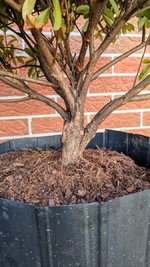Michigan Tree Murderer
Masterpiece
I bought this Nursery stock Pink Pearl about a month ago ($42), and I'm planning on watching it flower this season and then chopping it down to pre-bonsai town.
Pics worth more words than I feel like typing.

Says zone 7 but I've also seen these mentioned as zone 5 hardy. Are there different types of Pink Pearl?

This is what I'm working(killing) with

Use the tag for perspective, Or I can take more photos

I've been reading the 2025 Azalea contest thread the last few days, and despite that I'm still looking for styling and species advice. And @Deep Sea Diver and quite a few others in those threads seem very knowledgeable.
My thoughts are chop the branch on the right & prune the rest down. Lots of questions on the best fert, soil, morning sun or afternoon sun, bigger pot or inground for awhile. I've been two stepping this outside when it's above 32F and no ice storms. Mainly just mimicking the nursery instructions. It's in the attached garage when not outside.
Enough of my questions. I'll listen for now.
Pics worth more words than I feel like typing.

Says zone 7 but I've also seen these mentioned as zone 5 hardy. Are there different types of Pink Pearl?

This is what I'm working(killing) with

Use the tag for perspective, Or I can take more photos

I've been reading the 2025 Azalea contest thread the last few days, and despite that I'm still looking for styling and species advice. And @Deep Sea Diver and quite a few others in those threads seem very knowledgeable.
My thoughts are chop the branch on the right & prune the rest down. Lots of questions on the best fert, soil, morning sun or afternoon sun, bigger pot or inground for awhile. I've been two stepping this outside when it's above 32F and no ice storms. Mainly just mimicking the nursery instructions. It's in the attached garage when not outside.
Enough of my questions. I'll listen for now.





